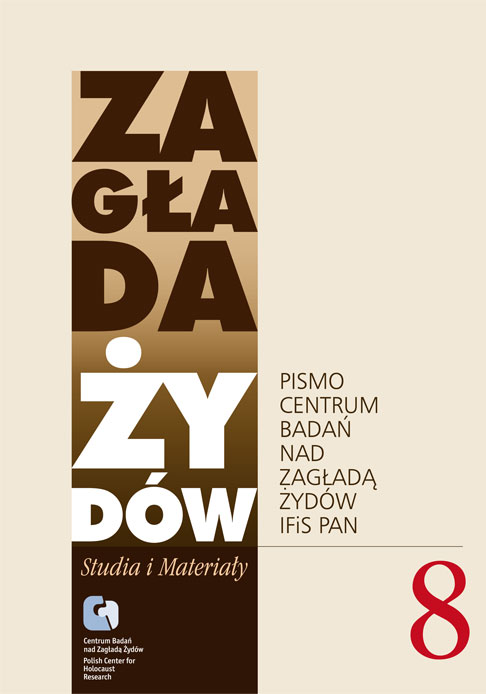Pogłoski w białostockim getcie. Przyczynek do historiografii Zagłady z perspektywy żydowskiej
Zagłada Żydów. Studia i Materiały, Nr 8 (2012), Strony: 214-236
Data zgłoszenia: 2020-10-28Data publikacji: 2012-12-02
 https://doi.org/10.32927/ZZSiM.633
https://doi.org/10.32927/ZZSiM.633
Abstrakt
The article deals with rumors, which were circulated in the Białystok ghetto. It seems that a rumor is a form of collective interpretation of reality whose function is to structure equivocal situations by explaining events or predicting them. The mood and behavior of individuals and groups may be influenced by rumors, in particular if they find themselves – as the Jews in the ghettos – in an exceptional and lifethreatening situation characterized by insecurity, isolation and uncertainty. The article analyzes rumors relating to the deportations of Jews from the ghetto and German mass murder actions. It addresses the following questions: Which impact did the different rumors have? How did the Judenrat and the ghetto population react to them? The article demonstrates that Jews acted upon their apprehension or misapprehension of events and that their subjective evaluation of the German extermination policy influenced their behavior and decisions
Słowa kluczowe
pogłoski , deportacje , niemiecka polityka eksterminacyjna , Judenrat , żydowska perspektywa i zachowania
Licencja
Prawa autorskie (c) 2012 Autor & "Zagłada Żydów. Studia i Materiały"

Utwór dostępny jest na licencji Creative Commons Uznanie autorstwa 4.0 Międzynarodowe.
https://creativecommons.org/licenses/by/4.0
Podobne artykuły
- Julia Machnowska, Sprawy synagog i cmentarzy żydowskich tuż po wojnie w dokumentach Ministerstwa Administracji Publicznej , Zagłada Żydów. Studia i Materiały: Nr 15 (2019)
- Alicja Podbielska, Święta rodzina z Markowej: kult Ulmów i polityka historyczna , Zagłada Żydów. Studia i Materiały: Nr 15 (2019)
- Krzysztof Persak, Ekshumacja, której (prawie) nie było. Prace archeologiczno-ekshumacyjne w Jedwabnem w 2001 r. i ich wyniki , Zagłada Żydów. Studia i Materiały: Nr 14 (2018)
- Marta Kubiszyn, Joanna Zętar, Miasto po Zagładzie. Dzielnica żydowska w Lublinie i jej upamiętnienia , Zagłada Żydów. Studia i Materiały: Nr 15 (2019)
- Dariusz Libionka, Apocrypha from the History of the Jewish Military Union and its Authors , Zagłada Żydów. Studia i Materiały: 2008: Holocaust Studies and Materials
- Dariusz Libionka, Alina Skibińska, “I swear to fight for a free and mighty Poland, carry out the orders of my superiors, so help me God.”Jews in the Home Army. An Episode from Ostrowiec Świętokrzyski , Zagłada Żydów. Studia i Materiały: 2008: Holocaust Studies and Materials
- Dariusz Libionka, Against a Brick Wall. Interventions of Kazimierz Papee, the Polish Ambassador at the Holy See with Regard to German Crimes in Poland, November 1942–January 1943 , Zagłada Żydów. Studia i Materiały: 2008: Holocaust Studies and Materials
- Ewa Koźmińska-Frejlak, A Testimony of Silence… Interview with Jerzy Lewiński, a former functionary of the Order Service in the Warsaw ghetto , Zagłada Żydów. Studia i Materiały: 2008: Holocaust Studies and Materials
- Romuald Jakub Weksler-Waszkinel, Father Stanisław Musiał's Struggle with Memory , Zagłada Żydów. Studia i Materiały: 2008: Holocaust Studies and Materials
- Marta Kubiszyn, Joanna Zętar, Miasto po Zagładzie. Dzielnica żydowska w Lublinie i jej upamiętnienia , Zagłada Żydów. Studia i Materiały: Nr 14 (2018)
<< < 1 2 3 4 5 6 7 8 9 10 11 12 13 14 15 16 17 18 19 20 21 > >>
Możesz również Rozpocznij zaawansowane wyszukiwanie podobieństw dla tego artykułu.
 English
English
 Język Polski
Język Polski








